brake fluid SMART FORTWO COUPE ELECTRIC DRIVE 2014 Owners Manual
[x] Cancel search | Manufacturer: SMART, Model Year: 2014, Model line: FORTWO COUPE ELECTRIC DRIVE, Model: SMART FORTWO COUPE ELECTRIC DRIVE 2014Pages: 222, PDF Size: 16.17 MB
Page 6 of 222
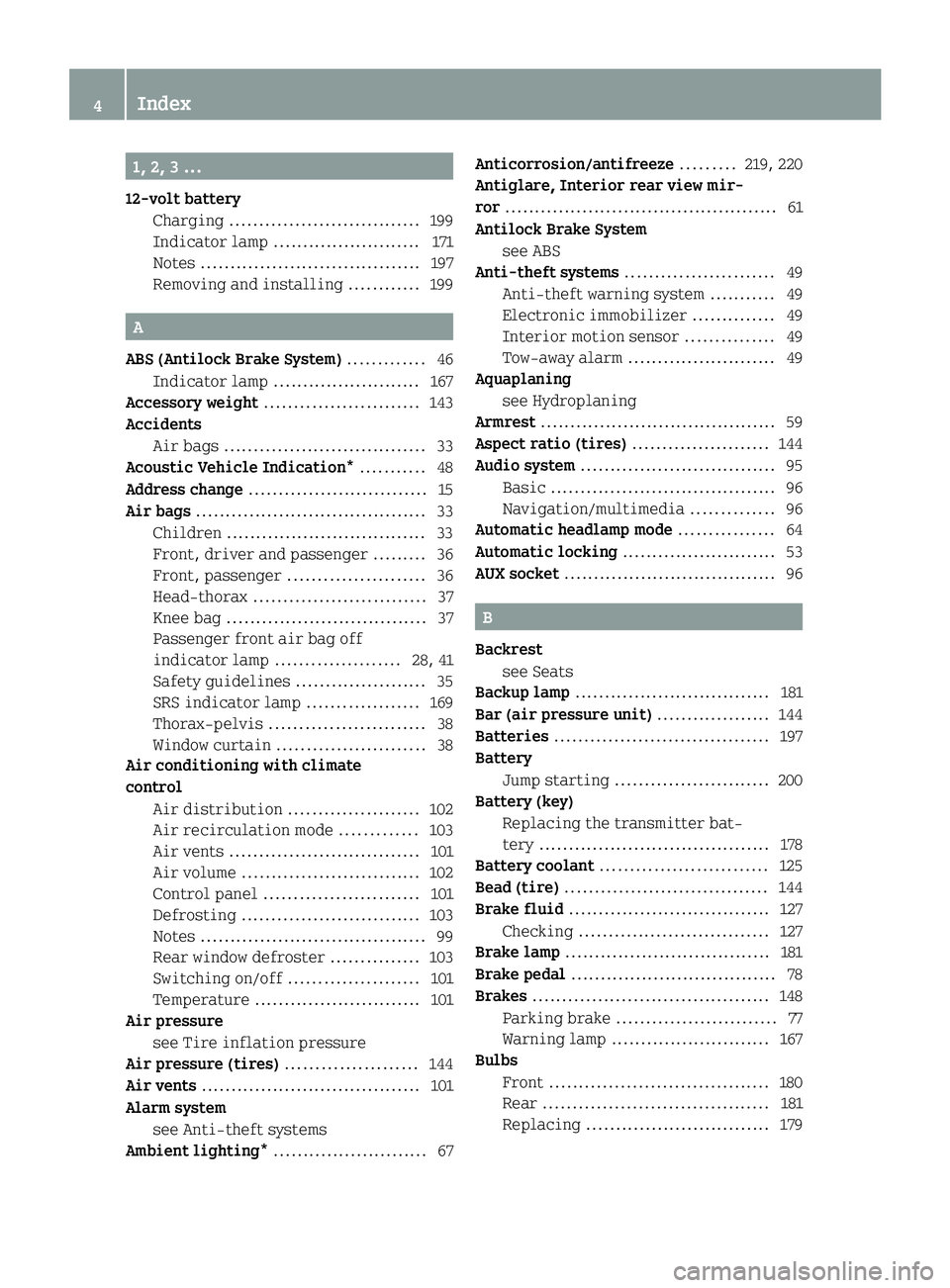
1, 2, 3 ...
12-volt battery Charging ................................ 199
Indicator lamp ........................ .171
Notes ..................................... 197
Removing and installing ............199 A
ABS (Antilock Brake System) .............46
Indicator lamp ......................... 167
Accessory weight .......................... 143
Accidents Air bags .................................. 33
Acoustic Vehicle Indication* ...........48
Address change .............................. 15
Air bags ....................................... 33
Children .................................. 33
Front, driver and passenger .........36
Front, passenger ....................... 36
Head-thorax ............................. 37
Knee bag .................................. 37
Passenger front air bag off
indicator lamp ..................... 28, 41
Safety guidelines ......................35
SRS indicator lamp ...................169
Thorax-pelvis .......................... 38
Window curtain ......................... 38
Air conditioning with climate
control
Air distribution ...................... 102
Air recirculation mode .............103
Air vents ................................ 101
Air volume .............................. 102
Control panel .......................... 101
Defrosting .............................. 103
Notes ...................................... 99
Rear window defroster ...............103
Switching on/off ...................... 101
Temperature ............................ 101
Air pressure
see Tire inflation pressure
Air pressure (tires) ......................144
Air vents ..................................... 101
Alarm system see Anti-theft systems
Ambient lighting* .......................... 67Anticorrosion/antifreeze
.........219, 220
Antiglare, Interior rear view mir-
ror .............................................. 61
Antilock Brake System see ABS
Anti-theft systems ......................... 49
Anti-theft warning system ...........49
Electronic immobilizer ..............49
Interior motion sensor ...............49
Tow-away alarm ......................... 49
Aquaplaning
see Hydroplaning
Armrest ....................................... .59
Aspect ratio (tires) .......................144
Audio system ................................. 95
Basic ...................................... 96
Navigation/multimedia ..............96
Automatic headlamp mode ................64
Automatic locking .......................... 53
AUX socket .................................... 96 B
Backrest see Seats
Backup lamp ................................. 181
Bar (air pressure unit) ...................144
Batteries .................................... 197
Battery Jump starting .......................... 200
Battery (key)
Replacing the transmitter bat-
tery ....................................... 178
Battery coolant ............................ 125
Bead (tire) .................................. 144
Brake fluid .................................. 127
Checking ................................ 127
Brake lamp ................................... 181
Brake pedal ................................... 78
Brakes ........................................ 148
Parking brake ........................... 77
Warning lamp ........................... 167
Bulbs
Front ..................................... 180
Rear ...................................... 181
Replacing ............................... 1794
Index
Page 8 of 222
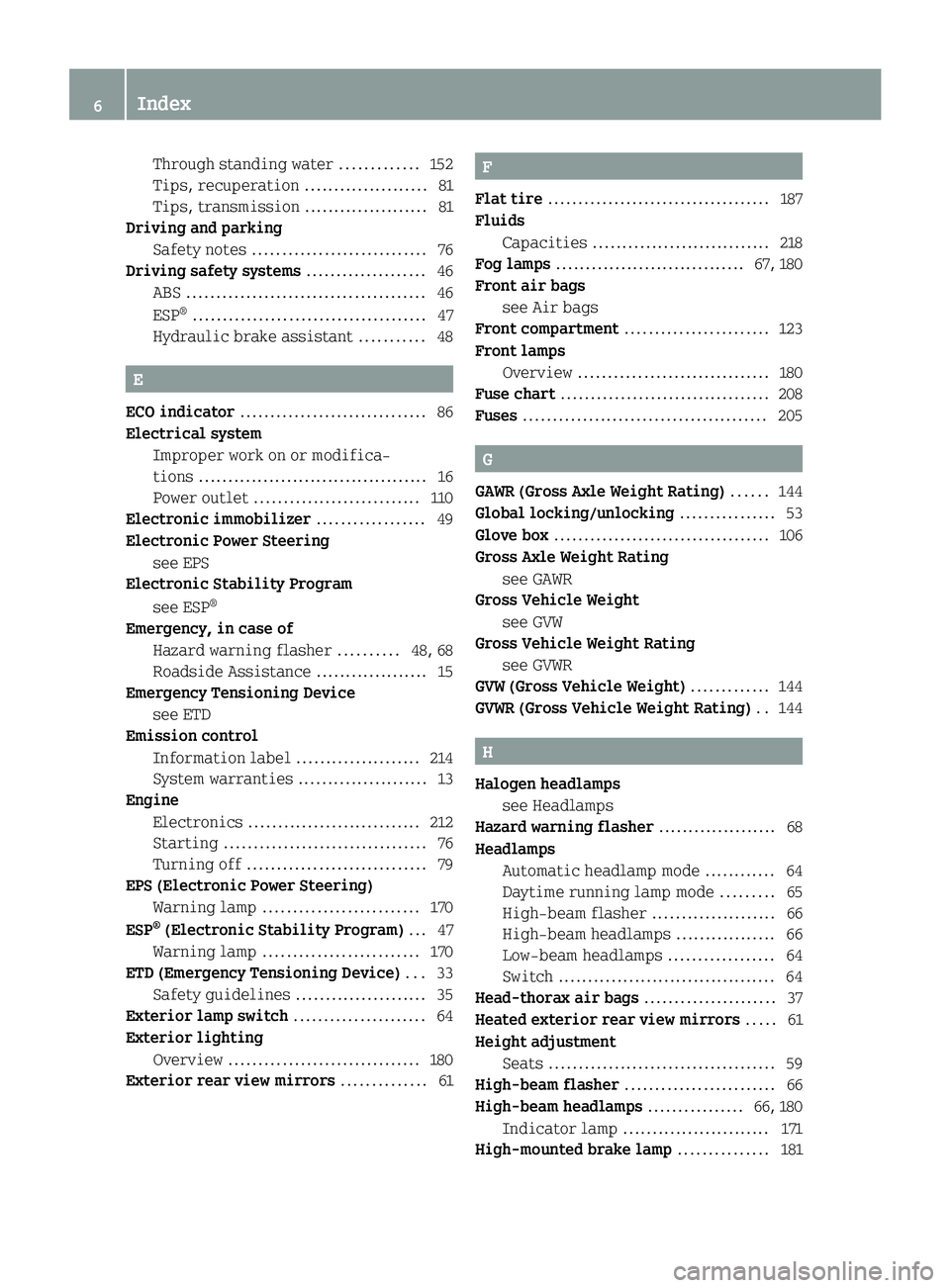
Through standing water
.............152
Tips, recuperation .....................81
Tips, transmission ..................... 81
Driving and parking
Safety notes ............................. 76
Driving safety systems ....................46
ABS ........................................ 46
ESP ®
....................................... 47
Hydraulic brake assistant ...........48 E
ECO indicator ............................... 86
Electrical system Improper work on or modifica-
tions ....................................... 16
Power outlet ............................ 110
Electronic immobilizer ..................49
Electronic Power Steering see EPS
Electronic Stability Program
see ESP ®
Emergency, in case of Hazard warning flasher ..........48, 68
Roadside Assistance ................... 15
Emergency Tensioning Device
see ETD
Emission control
Information label .....................214
System warranties ......................13
Engine
Electronics ............................. 212
Starting .................................. 76
Turning off .............................. 79
EPS (Electronic Power Steering)
Warning lamp .......................... 170
ESP ®
(Electronic Stability Program) ...47
Warning lamp .......................... 170
ETD (Emergency Tensioning Device) ...33
Safety guidelines ......................35
Exterior lamp switch ......................64
Exterior lighting Overview ................................ 180
Exterior rear view mirrors ..............61 F
Flat tire ..................................... 187
Fluids Capacities .............................. 218
Fog lamps ................................ 67, 180
Front air bags see Air bags
Front compartment ........................ 123
Front lamps Overview ................................ 180
Fuse chart ................................... 208
Fuses ......................................... 205 G
GAWR (Gross Axle Weight Rating) ......144
Global locking/unlocking ................53
Glove box .................................... 106
Gross Axle Weight Rating see GAWR
Gross Vehicle Weight
see GVW
Gross Vehicle Weight Rating
see GVWR
GVW (Gross Vehicle Weight) .............144
GVWR (Gross Vehicle Weight Rating) ..144 H
Halogen headlamps see Headlamps
Hazard warning flasher .................... 68
Headlamps Automatic headlamp mode ............ 64
Daytime running lamp mode .........65
High-beam flasher .....................66
High-beam headlamps ................. 66
Low-beam headlamps ..................64
Switch ..................................... 64
Head-thorax air bags ......................37
Heated exterior rear view mirrors .....61
Height adjustment Seats ...................................... 59
High-beam flasher ......................... 66
High-beam headlamps ................66, 180
Indicator lamp ......................... 171
High-mounted brake lamp ...............1816
Index
Page 12 of 222
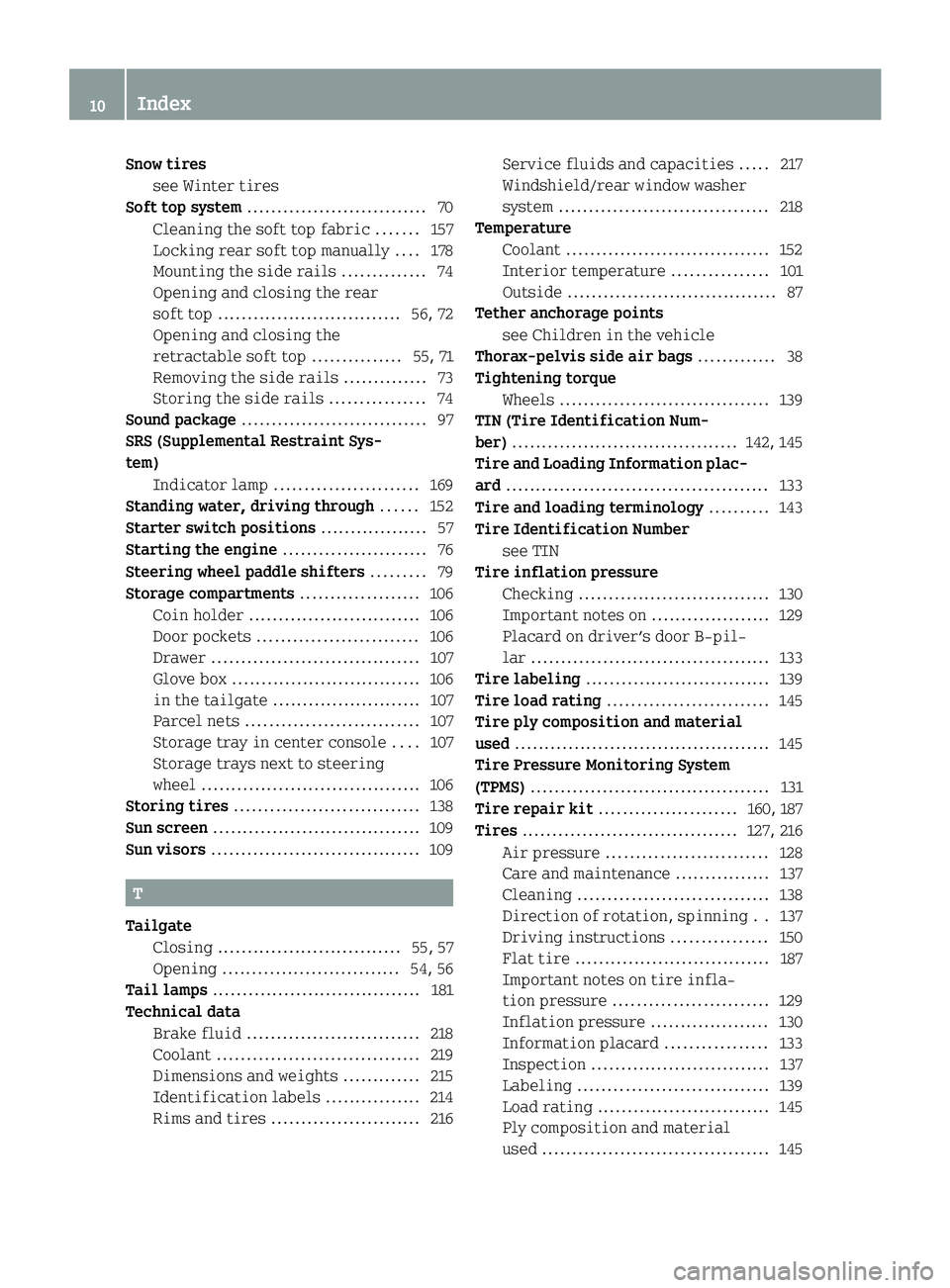
Snow tires
see Winter tires
Soft top system .............................. 70
Cleaning the soft top fabric .......157
Locking rear soft top manually ....178
Mounting the side rails ..............74
Opening and closing the rear
soft top ............................... 56, 72
Opening and closing the
retractable soft top ...............55, 71
Removing the side rails ..............73
Storing the side rails ................74
Sound package ............................... 97
SRS (Supplemental Restraint Sys-
tem)
Indicator lamp ........................ 169
Standing water, driving through ......152
Starter switch positions ..................57
Starting the engine ........................76
Steering wheel paddle shifters .........79
Storage compartments ....................106
Coin holder ............................. 106
Door pockets ........................... 106
Drawer ................................... 107
Glove box ................................ 106
in the tailgate ......................... 107
Parcel nets ............................. 107
Storage tray in center console ....107
Storage trays next to steering
wheel ..................................... 106
Storing tires ............................... 138
Sun screen ................................... 109
Sun visors ................................... 109T
Tailgate Closing ............................... 55, 57
Opening .............................. 54, 56
Tail lamps ................................... 181
Technical data Brake fluid ............................. 218
Coolant .................................. 219
Dimensions and weights .............215
Identification labels ................214
Rims and tires ......................... 216Service fluids and capacities
.....217
Windshield/rear window washer
system ................................... 218
Temperature
Coolant .................................. 152
Interior temperature ................101
Outside ................................... 87
Tether anchorage points
see Children in the vehicle
Thorax-pelvis side air bags .............38
Tightening torque Wheels ................................... 139
TIN (Tire Identification Num-
ber) ...................................... 142, 145
Tire and Loading Information plac-
ard ............................................ 133
Tire and loading terminology ..........143
Tire Identification Number see TIN
Tire inflation pressure
Checking ................................ 130
Important notes on ....................129
Placard on driver’s door B-pil-
lar ........................................ 133
Tire labeling ............................... 139
Tire load rating ........................... 145
Tire ply composition and material
used ........................................... 145
Tire Pressure Monitoring System
(TPMS) ........................................ 131
Tire repair kit ....................... 160, 187
Tires .................................... 127, 216
Air pressure ........................... 128
Care and maintenance ................137
Cleaning ................................ 138
Direction of rotation, spinning ..137
Driving instructions ................150
Flat tire ................................. 187
Important notes on tire infla-
tion pressure .......................... 129
Inflation pressure ....................130
Information placard .................133
Inspection .............................. 137
Labeling ................................ 139
Load rating ............................. 145
Ply composition and material
used ...................................... 14510
Index
Page 71 of 222
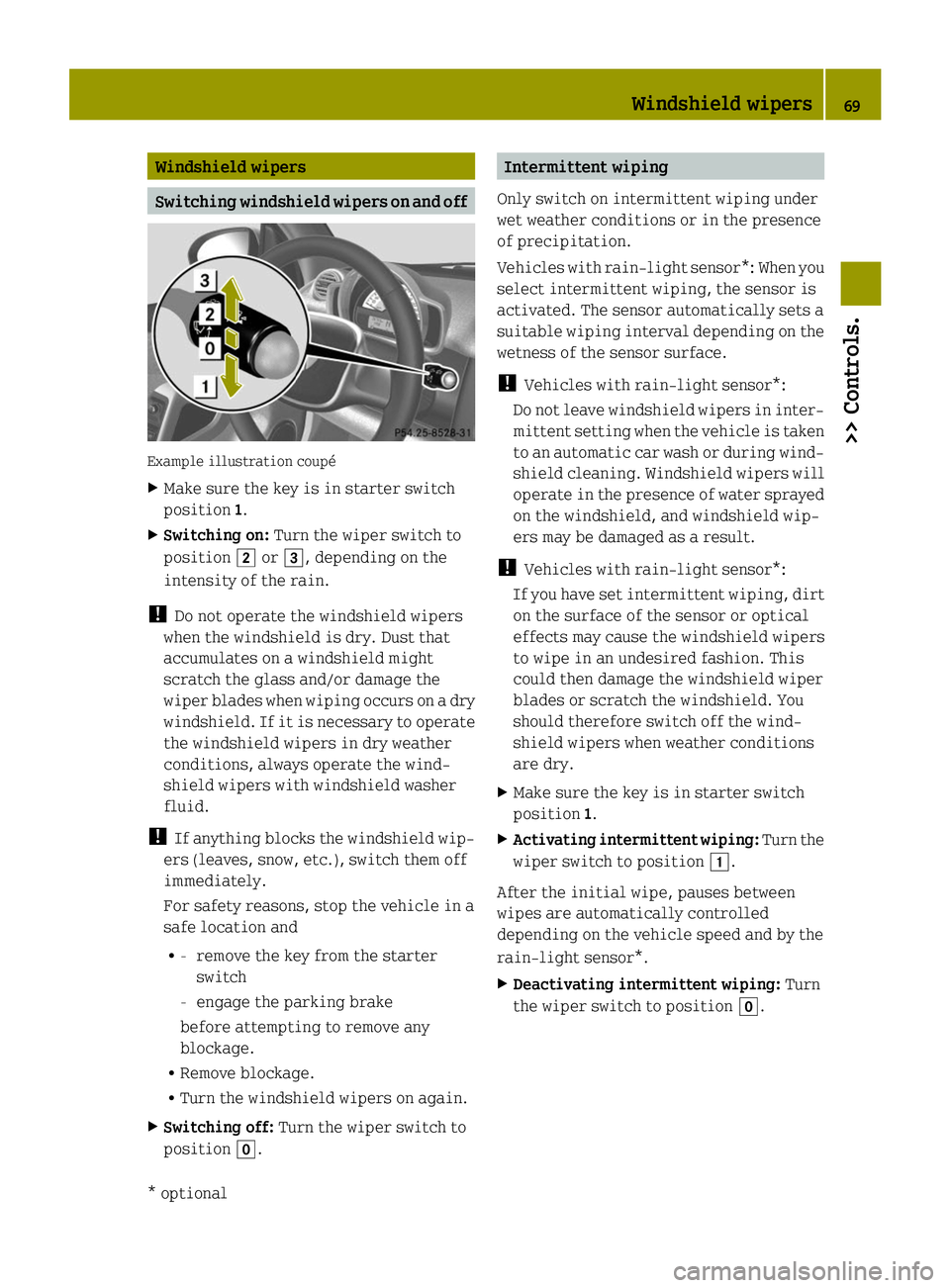
Windshield wipers
Switching windshield wipers on and off
Example illustration coupé
X
Make sure the key is in starter switch
position 1.
X Switching on: Turn the wiper switch to
position 0048or0049, depending on the
intensity of the rain.
! Do not operate the windshield wipers
when the windshield is dry. Dust that
accumulates on a windshield might
scratch the glass and/or damage the
wiper blades when wiping occurs on a dry
windshield. If it is necessary to operate
the windshield wipers in dry weather
conditions, always operate the wind-
shield wipers with windshield washer
fluid.
! If anything blocks the windshield wip-
ers (leaves, snow, etc.), switch them off
immediately.
For safety reasons, stop the vehicle in a
safe location and
R -
remove the key from the starter
switch
- engage the parking brake
before attempting to remove any
blockage.
R Remove blockage.
R Turn the windshield wipers on again.
X Switching off: Turn the wiper switch to
position 005A. Intermittent wiping
Only switch on intermittent wiping under
wet weather conditions or in the presence
of precipitation.
Vehicles with rain-light sensor*: When you
select intermittent wiping, the sensor is
activated. The sensor automatically sets a
suitable wiping interval depending on the
wetness of the sensor surface.
! Vehicles with rain-light sensor*:
Do not leave windshield wipers in inter-
mittent setting when the vehicle is taken
to an automatic car wash or during wind-
shield cleaning. Windshield wipers will
operate in the presence of water sprayed
on the windshield, and windshield wip-
ers may be damaged as a result.
! Vehicles with rain-light sensor*:
If you have set intermittent wiping, dirt
on the surface of the sensor or optical
effects may cause the windshield wipers
to wipe in an undesired fashion. This
could then damage the windshield wiper
blades or scratch the windshield. You
should therefore switch off the wind-
shield wipers when weather conditions
are dry.
X Make sure the key is in starter switch
position 1.
X Activating intermittent wiping: Turn the
wiper switch to position 0047.
After the initial wipe, pauses between
wipes are automatically controlled
depending on the vehicle speed and by the
rain-light sensor*.
X Deactivating intermittent wiping: Turn
the wiper switch to position 005A. Windshield wipers
69>> Controls.
* optional Z
Page 125 of 222
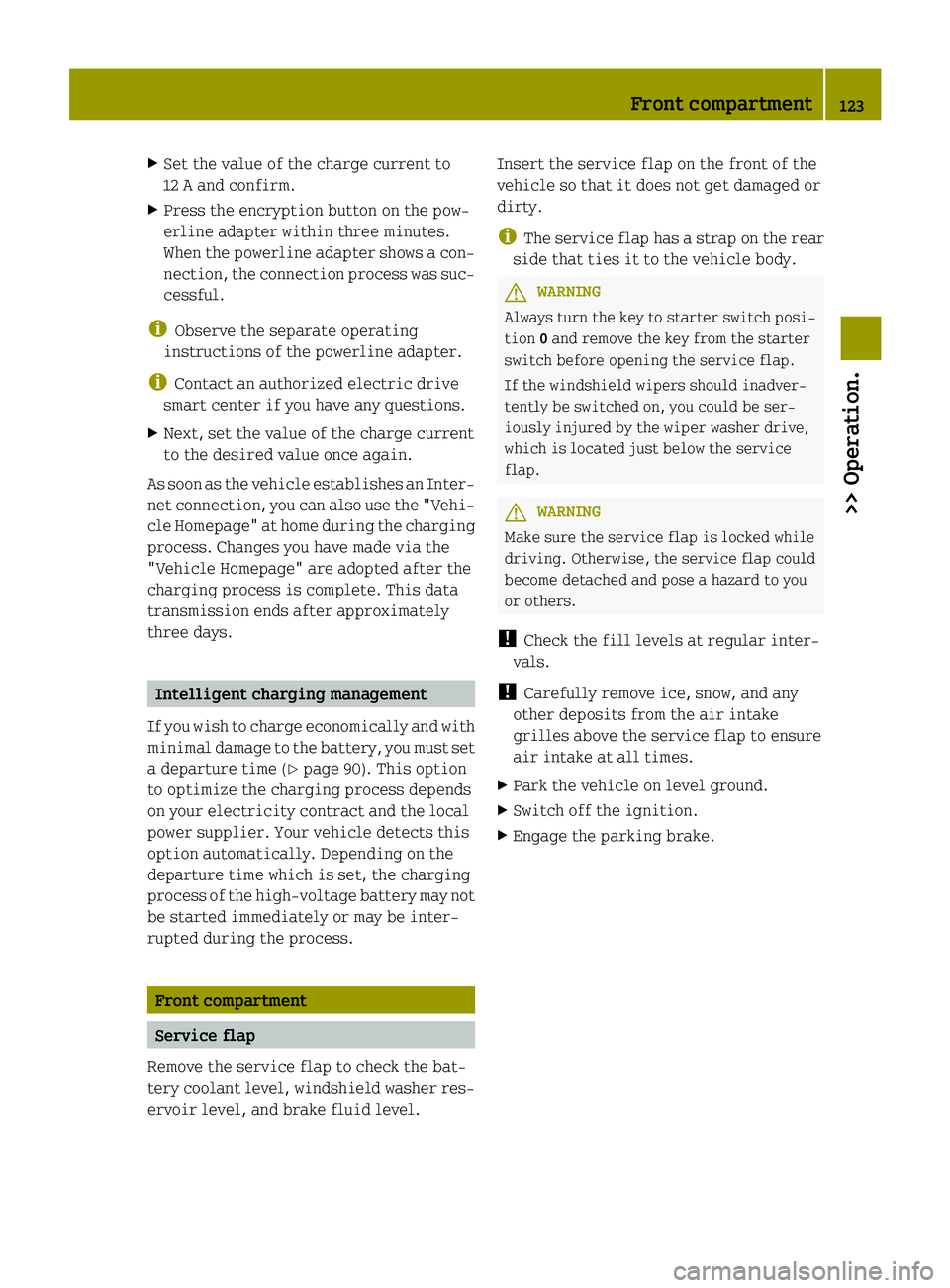
X
Set the value of the charge current to
12 A and confirm.
X Press the encryption button on the pow-
erline adapter within three minutes.
When the powerline adapter shows a con-
nection, the connection process was suc-
cessful.
i Observe the separate operating
instructions of the powerline adapter.
i Contact an authorized electric drive
smart center if you have any questions.
X Next, set the value of the charge current
to the desired value once again.
As soon as the vehicle establishes an Inter-
net connection, you can also use the "Vehi-
cle Homepage" at home during the charging
process. Changes you have made via the
"Vehicle Homepage" are adopted after the
charging process is complete. This data
transmission ends after approximately
three days. Intelligent charging management
If you wish to charge economically and with
minimal damage to the battery, you must set
a departure time ( Ypage 90). This option
to optimize the charging process depends
on your electricity contract and the local
power supplier. Your vehicle detects this
option automatically. Depending on the
departure time which is set, the charging
process of the high-voltage battery may not
be started immediately or may be inter-
rupted during the process. Front compartment
Service flap
Remove the service flap to check the bat-
tery coolant level, windshield washer res-
ervoir level, and brake fluid level. Insert the service flap on the front of the
vehicle so that it does not get damaged or
dirty.
i
The service flap has a strap on the rear
side that ties it to the vehicle body. G
WARNING
Always turn the key to starter switch posi-
tion 0and remove the key from the starter
switch before opening the service flap.
If the windshield wipers should inadver-
tently be switched on, you could be ser-
iously injured by the wiper washer drive,
which is located just below the service
flap. G
WARNING
Make sure the service flap is locked while
driving. Otherwise, the service flap could
become detached and pose a hazard to you
or others.
! Check the fill levels at regular inter-
vals.
! Carefully remove ice, snow, and any
other deposits from the air intake
grilles above the service flap to ensure
air intake at all times.
X Park the vehicle on level ground.
X Switch off the ignition.
X Engage the parking brake. Front compartment
123>> Operation. Z
Page 129 of 222
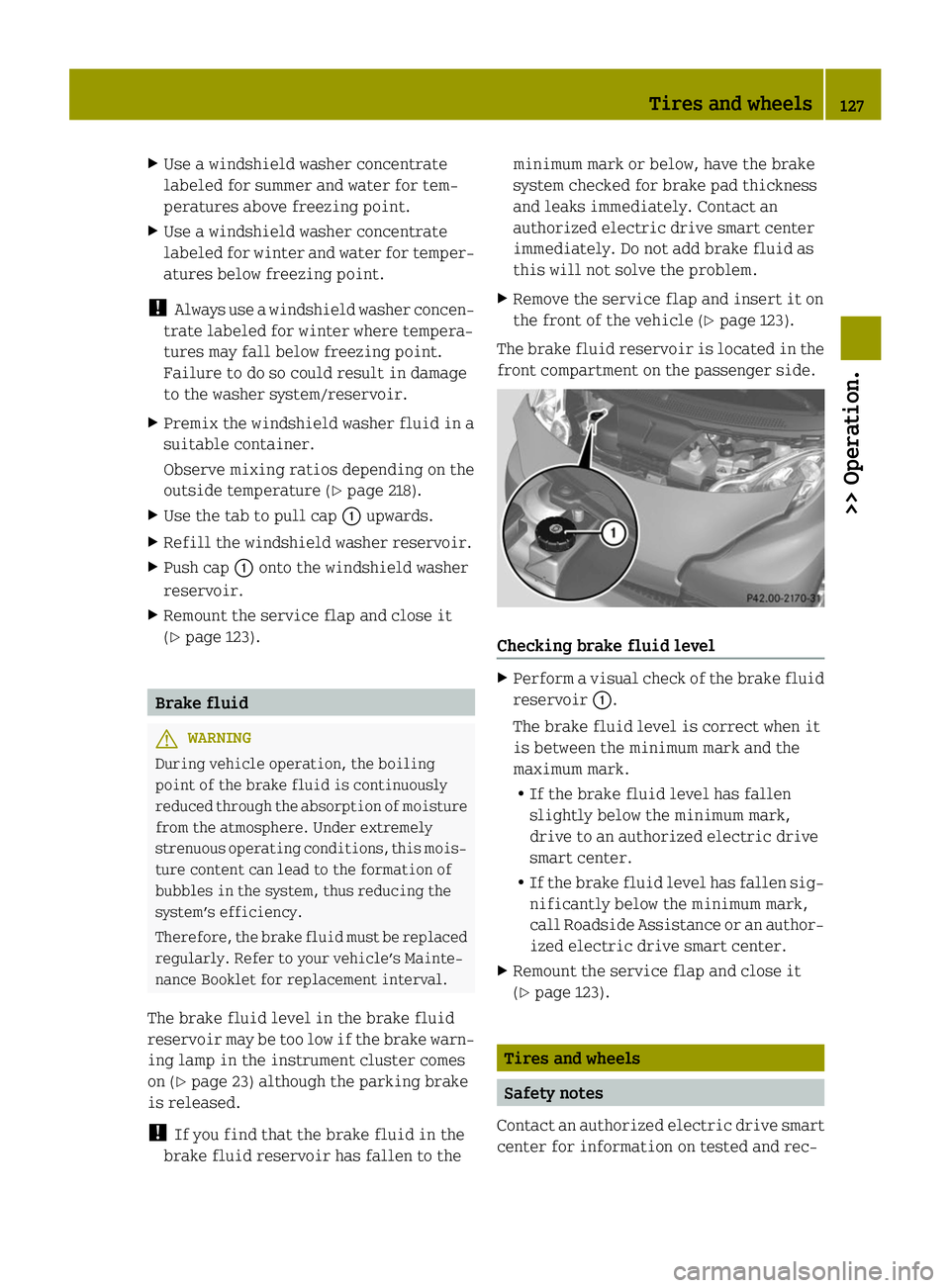
X
Use a windshield washer concentrate
labeled for summer and water for tem-
peratures above freezing point.
X Use a windshield washer concentrate
labeled for winter and water for temper-
atures below freezing point.
! Always use a windshield washer concen-
trate labeled for winter where tempera-
tures may fall below freezing point.
Failure to do so could result in damage
to the washer system/reservoir.
X Premix the windshield washer fluid in a
suitable container.
Observe mixing ratios depending on the
outside temperature (Y page 218).
X Use the tab to pull cap 0043upwards.
X Refill the windshield washer reservoir.
X Push cap 0043onto the windshield washer
reservoir.
X Remount the service flap and close it
(Y page 123). Brake fluid
G
WARNING
During vehicle operation, the boiling
point of the brake fluid is continuously
reduced through the absorption of moisture
from the atmosphere. Under extremely
strenuous operating conditions, this mois-
ture content can lead to the formation of
bubbles in the system, thus reducing the
system’s efficiency.
Therefore, the brake fluid must be replaced
regularly. Refer to your vehicle’s Mainte-
nance Booklet for replacement interval.
The brake fluid level in the brake fluid
reservoir may be too low if the brake warn-
ing lamp in the instrument cluster comes
on (Y page 23) although the parking brake
is released.
! If you find that the brake fluid in the
brake fluid reservoir has fallen to the minimum mark or below, have the brake
system checked for brake pad thickness
and leaks immediately. Contact an
authorized electric drive smart center
immediately. Do not add brake fluid as
this will not solve the problem.
X Remove the service flap and insert it on
the front of the vehicle (Y page 123).
The brake fluid reservoir is located in the
front compartment on the passenger side. Checking brake fluid level
X
Perform a visual check of the brake fluid
reservoir 0043.
The brake fluid level is correct when it
is between the minimum mark and the
maximum mark.
R If the brake fluid level has fallen
slightly below the minimum mark,
drive to an authorized electric drive
smart center.
R If the brake fluid level has fallen sig-
nificantly below the minimum mark,
call Roadside Assistance or an author-
ized electric drive smart center.
X Remount the service flap and close it
(Y page 123). Tires and wheels
Safety notes
Contact an authorized electric drive smart
center for information on tested and rec- Tires and wheels
127>> Operation. Z
Page 150 of 222
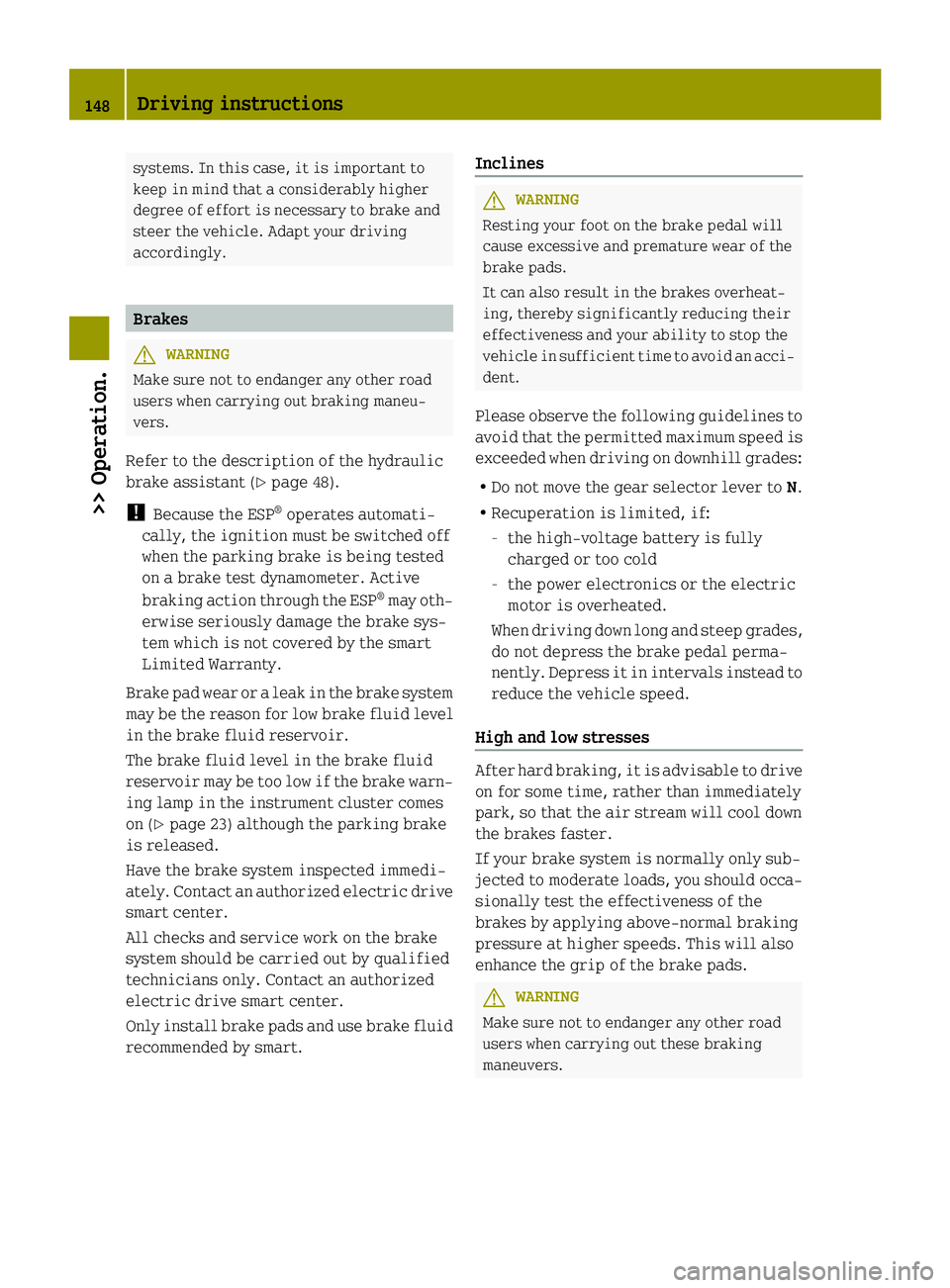
systems. In this case, it is important to
keep in mind that a considerably higher
degree of effort is necessary to brake and
steer the vehicle. Adapt your driving
accordingly. Brakes
G
WARNING
Make sure not to endanger any other road
users when carrying out braking maneu-
vers.
Refer to the description of the hydraulic
brake assistant (Y page 48).
! Because the ESP ®
operates automati-
cally, the ignition must be switched off
when the parking brake is being tested
on a brake test dynamometer. Active
braking action through the ESP ®
may oth-
erwise seriously damage the brake sys-
tem which is not covered by the smart
Limited Warranty.
Brake pad wear or a leak in the brake system
may be the reason for low brake fluid level
in the brake fluid reservoir.
The brake fluid level in the brake fluid
reservoir may be too low if the brake warn-
ing lamp in the instrument cluster comes
on (Y page 23) although the parking brake
is released.
Have the brake system inspected immedi-
ately. Contact an authorized electric drive
smart center.
All checks and service work on the brake
system should be carried out by qualified
technicians only. Contact an authorized
electric drive smart center.
Only install brake pads and use brake fluid
recommended by smart. Inclines G
WARNING
Resting your foot on the brake pedal will
cause excessive and premature wear of the
brake pads.
It can also result in the brakes overheat-
ing, thereby significantly reducing their
effectiveness and your ability to stop the
vehicle in sufficient time to avoid an acci-
dent.
Please observe the following guidelines to
avoid that the permitted maximum speed is
exceeded when driving on downhill grades:
R Do not move the gear selector lever to N.
R Recuperation is limited, if:
-the high-voltage battery is fully
charged or too cold
- the power electronics or the electric
motor is overheated.
When driving down long and steep grades,
do not depress the brake pedal perma-
nently. Depress it in intervals instead to
reduce the vehicle speed.
High and low stresses After hard braking, it is advisable to drive
on for some time, rather than immediately
park, so that the air stream will cool down
the brakes faster.
If your brake system is normally only sub-
jected to moderate loads, you should occa-
sionally test the effectiveness of the
brakes by applying above-normal braking
pressure at higher speeds. This will also
enhance the grip of the brake pads.
G
WARNING
Make sure not to endanger any other road
users when carrying out these braking
maneuvers. 148
Driving instructions>> Operation.
Page 151 of 222
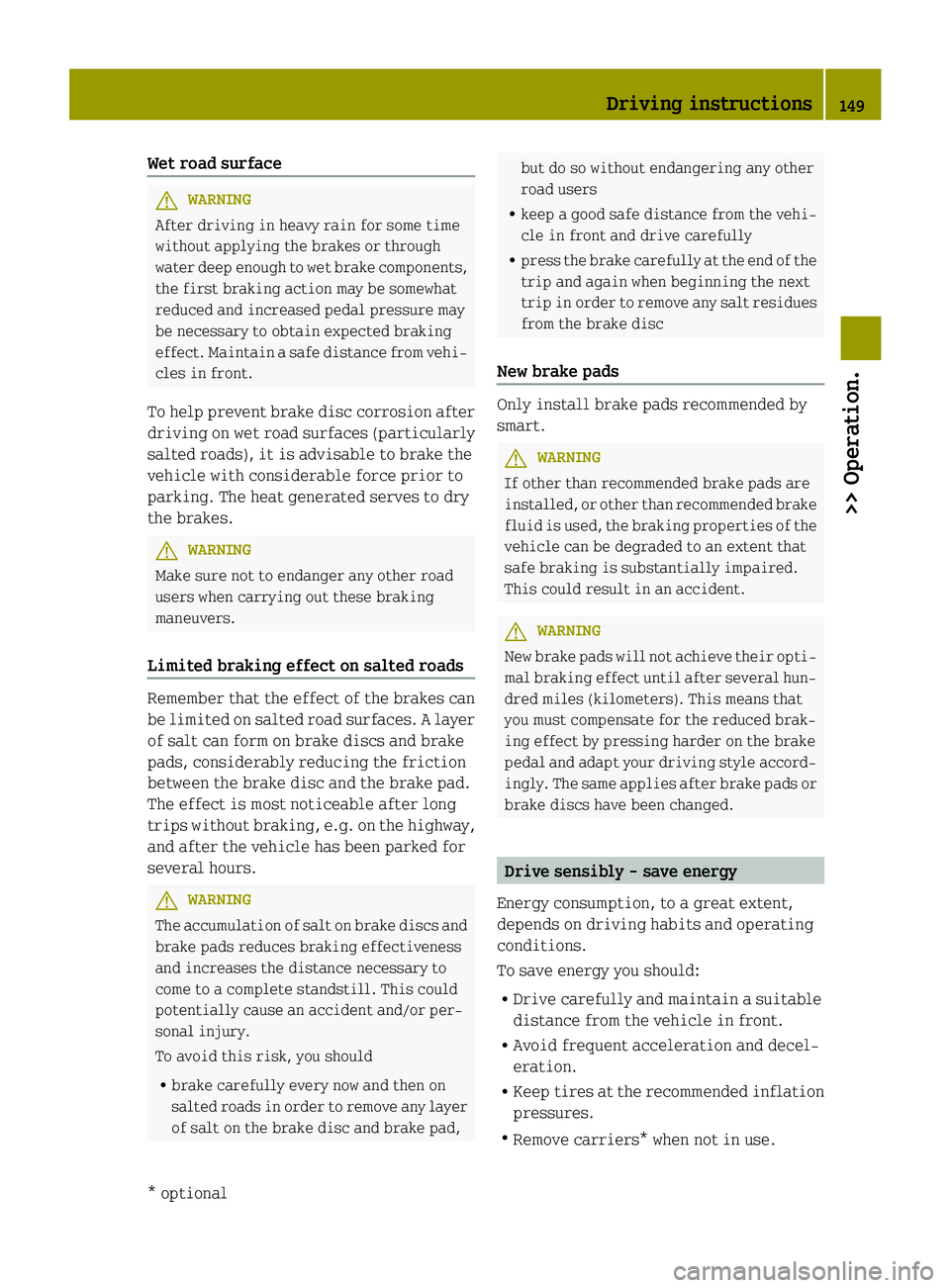
Wet road surface
G
WARNING
After driving in heavy rain for some time
without applying the brakes or through
water deep enough to wet brake components,
the first braking action may be somewhat
reduced and increased pedal pressure may
be necessary to obtain expected braking
effect. Maintain a safe distance from vehi-
cles in front.
To help prevent brake disc corrosion after
driving on wet road surfaces (particularly
salted roads), it is advisable to brake the
vehicle with considerable force prior to
parking. The heat generated serves to dry
the brakes. G
WARNING
Make sure not to endanger any other road
users when carrying out these braking
maneuvers.
Limited braking effect on salted roads Remember that the effect of the brakes can
be limited on salted road surfaces. A layer
of salt can form on brake discs and brake
pads, considerably reducing the friction
between the brake disc and the brake pad.
The effect is most noticeable after long
trips without braking, e.g. on the highway,
and after the vehicle has been parked for
several hours.
G
WARNING
The accumulation of salt on brake discs and
brake pads reduces braking effectiveness
and increases the distance necessary to
come to a complete standstill. This could
potentially cause an accident and/or per-
sonal injury.
To avoid this risk, you should
R brake carefully every now and then on
salted roads in order to remove any layer
of salt on the brake disc and brake pad, but do so without endangering any other
road users
R keep a good safe distance from the vehi-
cle in front and drive carefully
R press the brake carefully at the end of the
trip and again when beginning the next
trip in order to remove any salt residues
from the brake disc
New brake pads Only install brake pads recommended by
smart.
G
WARNING
If other than recommended brake pads are
installed, or other than recommended brake
fluid is used, the braking properties of the
vehicle can be degraded to an extent that
safe braking is substantially impaired.
This could result in an accident. G
WARNING
New brake pads will not achieve their opti-
mal braking effect until after several hun-
dred miles (kilometers). This means that
you must compensate for the reduced brak-
ing effect by pressing harder on the brake
pedal and adapt your driving style accord-
ingly. The same applies after brake pads or
brake discs have been changed. Drive sensibly - save energy
Energy consumption, to a great extent,
depends on driving habits and operating
conditions.
To save energy you should:
R Drive carefully and maintain a suitable
distance from the vehicle in front.
R Avoid frequent acceleration and decel-
eration.
R Keep tires at the recommended inflation
pressures.
R Remove carriers* when not in use. Driving instructions
149>> Operation.
* optional Z
Page 155 of 222
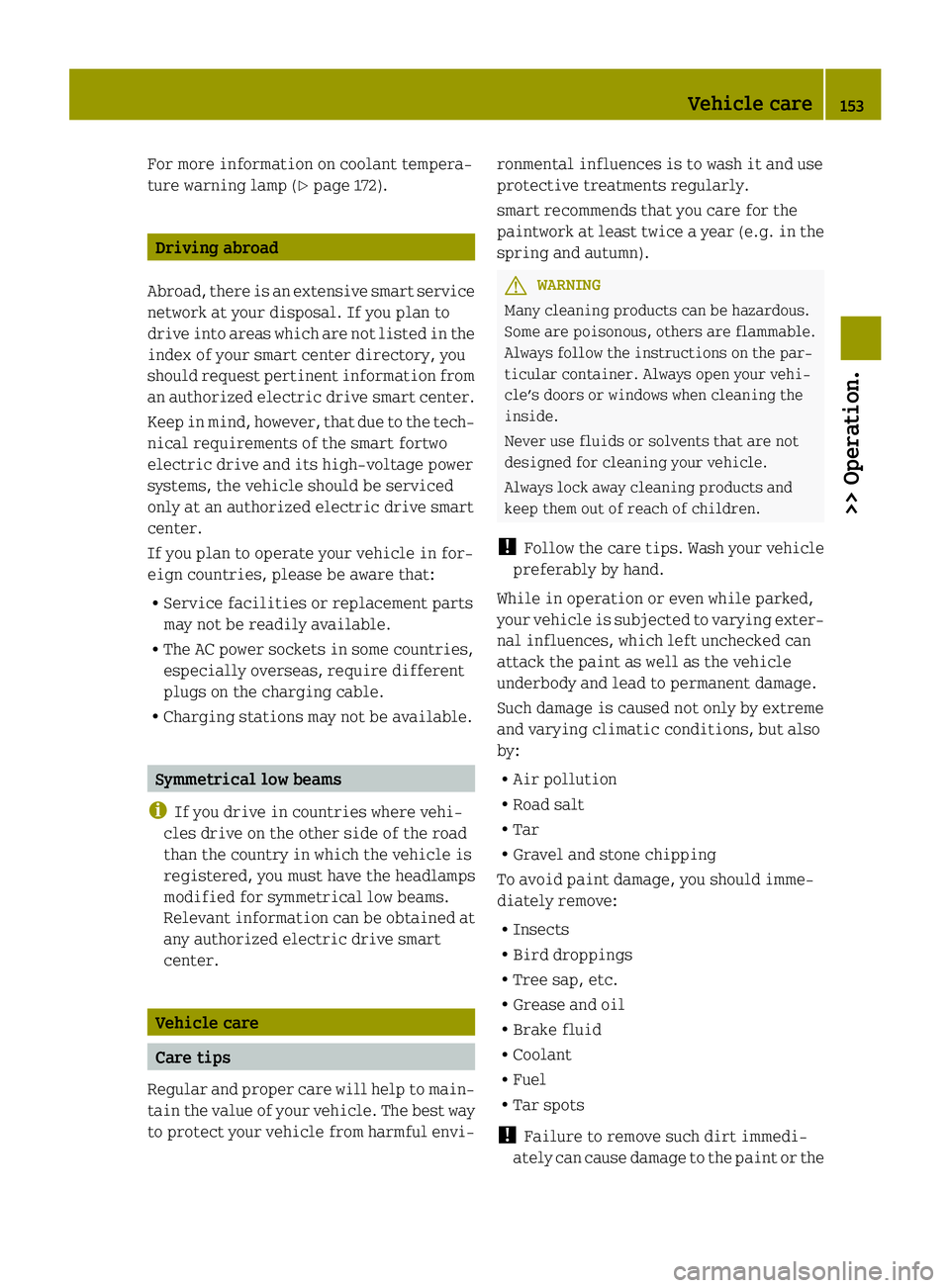
For more information on coolant tempera-
ture warning lamp (Y page 172).Driving abroad
Abroad, there is an extensive smart service
network at your disposal. If you plan to
drive into areas which are not listed in the
index of your smart center directory, you
should request pertinent information from
an authorized electric drive smart center.
Keep in mind, however, that due to the tech-
nical requirements of the smart fortwo
electric drive and its high-voltage power
systems, the vehicle should be serviced
only at an authorized electric drive smart
center.
If you plan to operate your vehicle in for-
eign countries, please be aware that:
R Service facilities or replacement parts
may not be readily available.
R The AC power sockets in some countries,
especially overseas, require different
plugs on the charging cable.
R Charging stations may not be available. Symmetrical low beams
i If you drive in countries where vehi-
cles drive on the other side of the road
than the country in which the vehicle is
registered, you must have the headlamps
modified for symmetrical low beams.
Relevant information can be obtained at
any authorized electric drive smart
center. Vehicle care
Care tips
Regular and proper care will help to main-
tain the value of your vehicle. The best way
to protect your vehicle from harmful envi- ronmental influences is to wash it and use
protective treatments regularly.
smart recommends that you care for the
paintwork at least twice a year (e.g. in the
spring and autumn). G
WARNING
Many cleaning products can be hazardous.
Some are poisonous, others are flammable.
Always follow the instructions on the par-
ticular container. Always open your vehi-
cle’s doors or windows when cleaning the
inside.
Never use fluids or solvents that are not
designed for cleaning your vehicle.
Always lock away cleaning products and
keep them out of reach of children.
! Follow the care tips. Wash your vehicle
preferably by hand.
While in operation or even while parked,
your vehicle is subjected to varying exter-
nal influences, which left unchecked can
attack the paint as well as the vehicle
underbody and lead to permanent damage.
Such damage is caused not only by extreme
and varying climatic conditions, but also
by:
R Air pollution
R Road salt
R Tar
R Gravel and stone chipping
To avoid paint damage, you should imme-
diately remove:
R Insects
R Bird droppings
R Tree sap, etc.
R Grease and oil
R Brake fluid
R Coolant
R Fuel
R Tar spots
! Failure to remove such dirt immedi-
ately can cause damage to the paint or the Vehicle care
153>> Operation. Z
Page 169 of 222
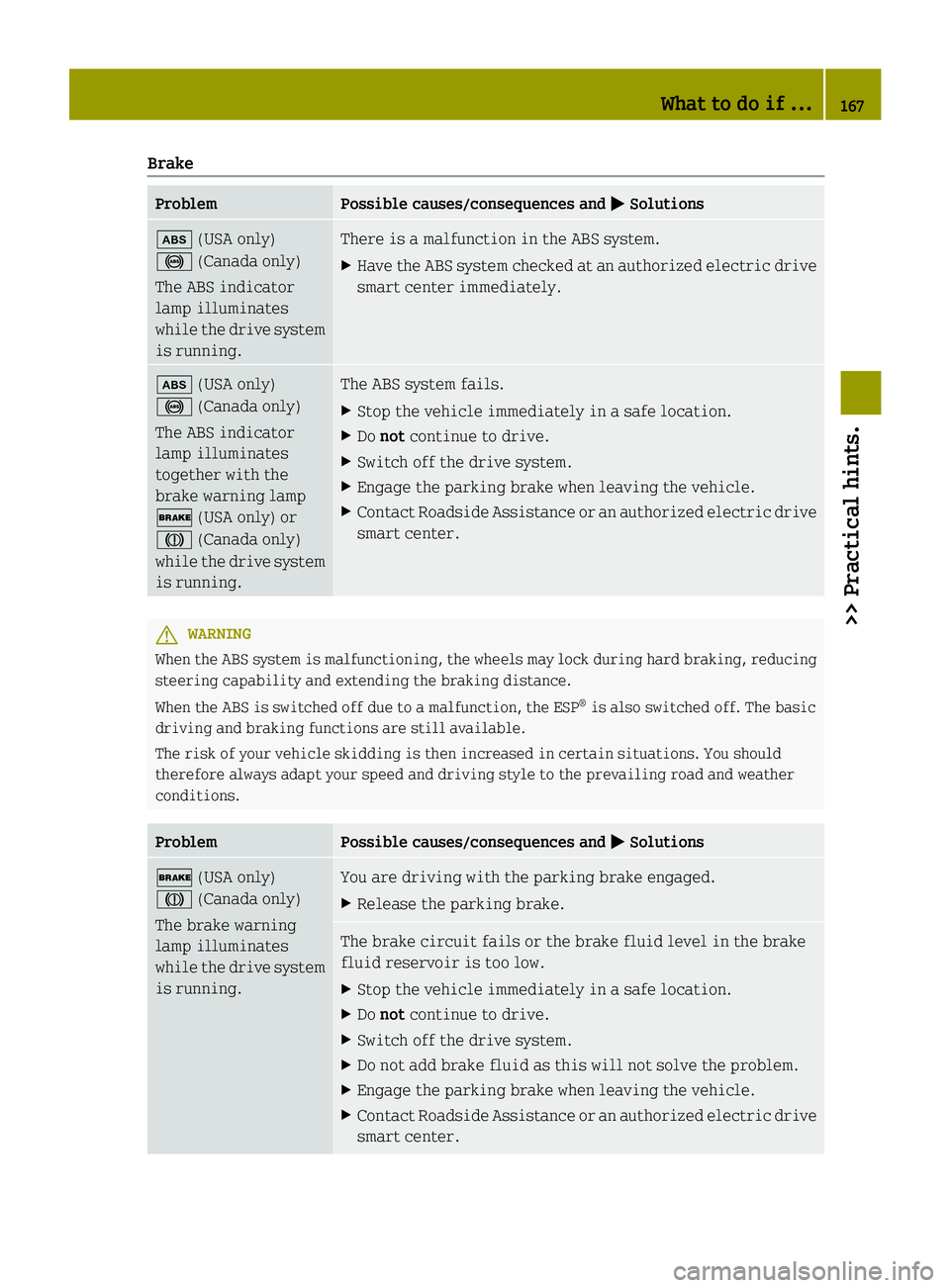
Brake
Problem Possible causes/consequences and
0050
0050Solutions 00DF
(USA only)
0025 (Canada only)
The ABS indicator
lamp illuminates
while the drive system
is running. There is a malfunction in the ABS system.
X
Have the ABS system checked at an authorized electric drive
smart center immediately. 00DF
(USA only)
0025 (Canada only)
The ABS indicator
lamp illuminates
together with the
brake warning lamp
0027 (USA only) or
004D (Canada only)
while the drive system
is running. The ABS system fails.
X
Stop the vehicle immediately in a safe location.
X Do not continue to drive.
X Switch off the drive system.
X Engage the parking brake when leaving the vehicle.
X Contact Roadside Assistance or an authorized electric drive
smart center. G
WARNING
When the ABS system is malfunctioning, the wheels may lock during hard braking, reducing
steering capability and extending the braking distance.
When the ABS is switched off due to a malfunction, the ESP ®
is also switched off. The basic
driving and braking functions are still available.
The risk of your vehicle skidding is then increased in certain situations. You should
therefore always adapt your speed and driving style to the prevailing road and weather
conditions. Problem Possible causes/consequences and
0050 0050Solutions 0027
(USA only)
004D (Canada only)
The brake warning
lamp illuminates
while the drive system
is running. You are driving with the parking brake engaged.
X
Release the parking brake. The brake circuit fails or the brake fluid level in the brake
fluid reservoir is too low.
X
Stop the vehicle immediately in a safe location.
X Do not continue to drive.
X Switch off the drive system.
X Do not add brake fluid as this will not solve the problem.
X Engage the parking brake when leaving the vehicle.
X Contact Roadside Assistance or an authorized electric drive
smart center. What to do if ...
167>> Practical hints. Z